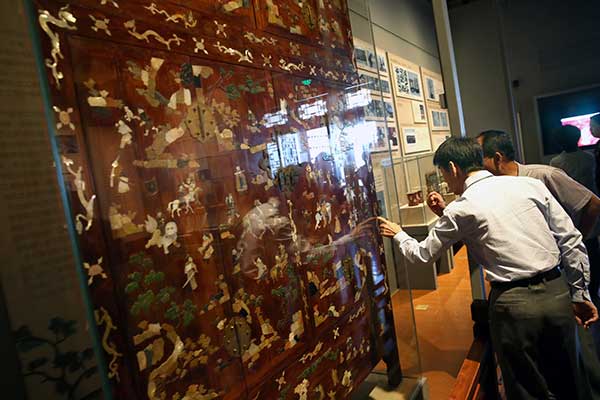
An exhibition displaying old royal craftsmanship began on Friday at China's former imperial palace.
The Palace Museum, also known as the Forbidden City, is displaying 43 sets of cultural relics, including antique clocks, embroidery and furniture, to showcase its efforts in cultural relic restoration in the past two years.
According to Shan Jixiang, director of the museum, the highlight of the exhibition is not the relics, but the technicians' painstaking process to give life back to them.
"Restoration of these treasures began with their birth," Shan says citing files from the Qing Dynasty (1644-1911) that record their previous restorations.
Each exhibit is displayed with details of the restoration process.
The museum set up its restoration and technology department in 1988. It combines traditional techniques with modern technology.
Large-scale restoration of cultural relics began only in 2013, after a detailed seven-year study of the museum's inventory.
Wang Jin, 54, who has been an antique-clock restorer since 1978, proudly introduces a 17th-century gilded British clock to visitors.
Though this delicate article was once gifted to Emperor Qianlong (1711-99), Wang says its condition was poor when it was discovered in the warehouse.
"We also found evidence of an incomplete restoration done at least a century ago," he says. "Maybe it was too complicated, so the restorers finally gave up."
It took 10 months for Wang Jin and his apprentice to restore this old timepiece. Wang says that new components had to be handmade.
"There are dozens of unrepaired clocks in our warehouse. If we are able to restore only one article a year, who knows how long we will need."
The museum is now looking for expertise from outside to help restore the treasures.
They have met with some success because in the late Qing Dynasty, many artisans in the Beijing area worked for royal institutions, and some of their workshops exist to this day.
Tongxinghe, a wooden furniture workshop dating back to 1836, is one of them.
Wang Laifeng, 62, a furniture restorer with more than 40 years experience repaired a redwood table from the late Ming Dynasty (1368-1644) for the museum, and it is displayed in the exhibition.
Shan says that a 40,000-square-meter area displaying cultural relic restoration techniques will be set up in their branch museum. Construction will be completed by the end of this year.
"What is displayed now is only the tip of the iceberg," he says.
Shan also expects more similar exhibitions in the future.
"People will thus better understand our behind-the-scenes work, and experience the miracles in this process."





